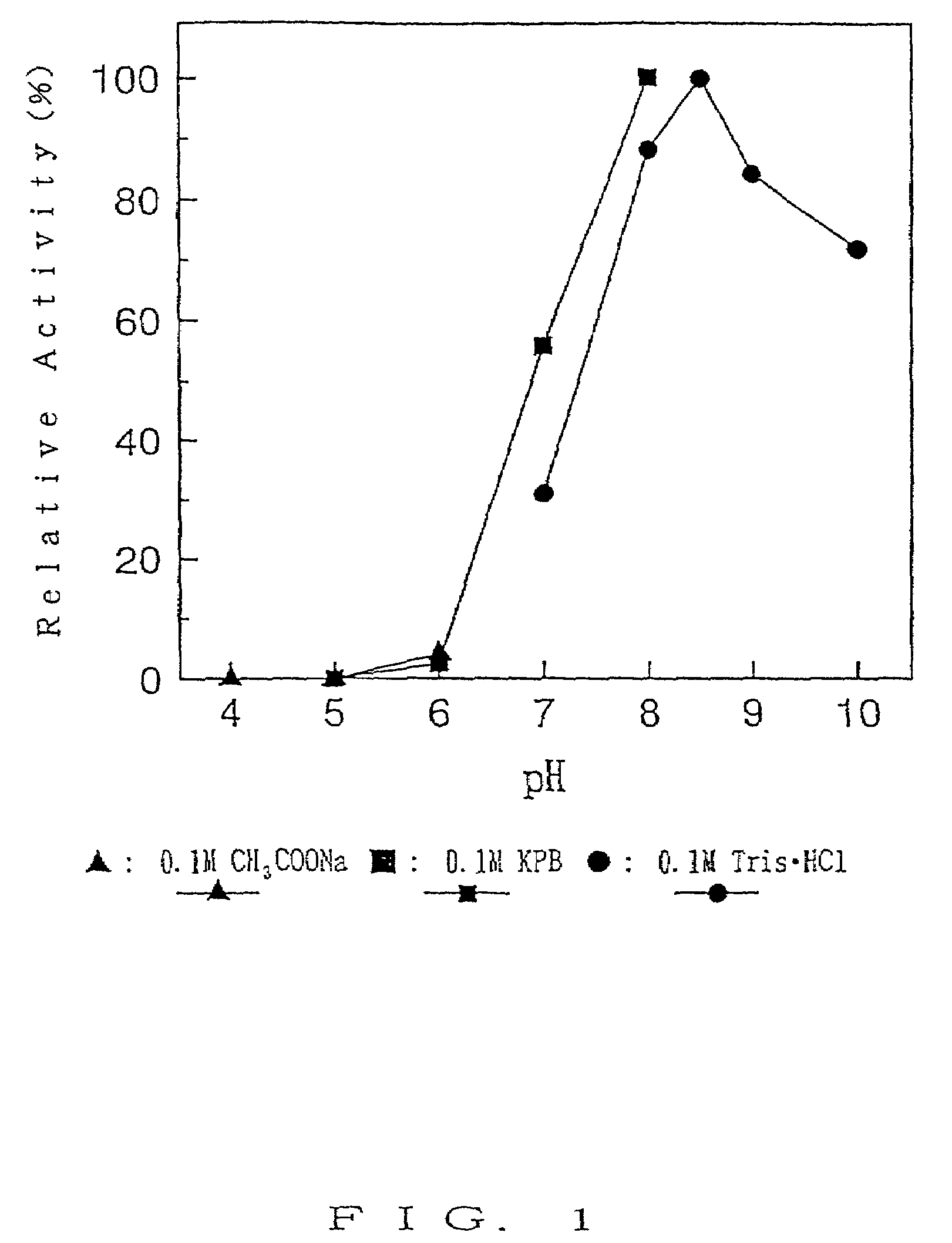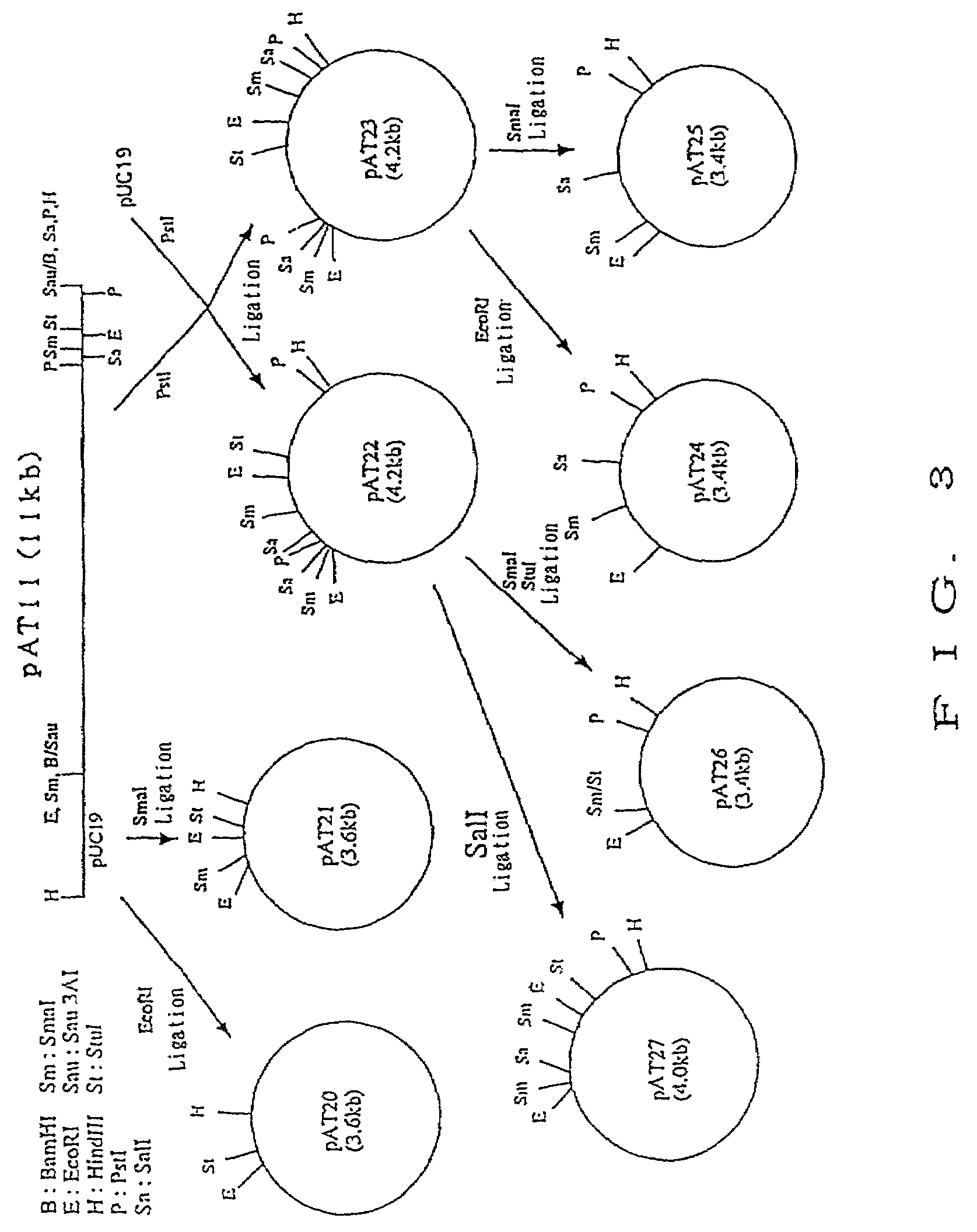Producing optically active amino compounds
a technology of amino compounds and amino acids, applied in the direction of enzymology, organic chemistry, transferases, etc., can solve the problems of difficult to use this method for practical purposes, method cannot be considered advantageous from the cost aspect, and poor reproducibility of this method by means of this method, etc., to achieve efficient and inexpensive effects
- Summary
- Abstract
- Description
- Claims
- Application Information
AI Technical Summary
Benefits of technology
Problems solved by technology
Method used
Image
Examples
example 1
[0139]Each 2 g of soil samples collected at various places in this country was suspended in 5 ml physiological saline. The 0.2 ml supernatant thereof was added to a 4 ml S medium (2 g / L KH2PO4, 2 g / L K2HPO4, 0.3 g / L MgSO4.7H2O, 5 g / L glycerol, 3 g / L NaCl, 1 g / L yeast extract powder, 0.004 g / L FeSO4.7H2O, 0.0005 g / L ZnSO4.7H2O, 0.0005 g / L MnCl2.4H2O (pH 7.5) after a treatment of autoclaving; and 2-oxoglutaric acid or pyruvic acid and (R)-1-(3,4-dimethoxyphenyl)-2-aminopropane, each of which is filtrated by a microorganisms exclusion filter, being added so as to give final concentrations 1.5 g / L and 1.0 g / L, respectively) The resulting culture was subjected to an enrichment culture at 30° C. for 3 to 7 days. Each 0.2 ml culture in which the bacteria were grown was spread on an S-medium plate containing 1.5% agar, and the colonies were grown by culturing at 30° C. The grown colonies were subjected to shaking culture in the S-medium, respectively. After harvesting the cells, they were s...
example 2
[0141]When culturing the Arthrobacter species KNK168 strain by the method described in Example 1, (RS)-1-methylpropylamine, (RS)-1-methylbutylamine, (RS)-3-amino-2,2-dimethylbutane, (RS)-2-amino-1-butanol, or (RS)-1-phenylethylamine was added to the medium in place of (R)-1-(3,4-dimethoxyphenyl)-2-aminopropane ((R)-DMA). The cells were separated from the culture, and the reaction was carried out at 30° C. for 20 hours using the above cells in a reaction mixture containing 1% 1-(3,4-dimethoxyphenyl)-2-propanone and 1% (RS)-1-methylpropylamine. As a result, an increase of the reactivity was observed as shown in Table 4.
[0142]
TABLE 4(R)-DMA FormedInducer(%)(RS)-1-Methylpropylamine22.3(RS)-1-Methylbutylamine13.0(RS)-1-Phenylethylamine8.0(RS)-3-Amino-2,2-dimethylbutane18.6(RS)-2-Amino-1-butanol12.9(R)-DMA0.9No Addition0.3
example 3
[0143]The Arthrobacter species KNK168 strain was inoculated to an R medium (5 g / L KH2PO4, 5 g / L K2HPO4, 3 g / L NaCl, 1 g / L MgSO4.7H2O, 0.005 g / L FeSO4.7H2O, 0.001 g / L ZnSO4.7H2O, 0.001 g / L MnCl2.4H2O (pH 7.5) after a treatment of autoclaving, 15 g / L glycerol, 2 g / L yeast extract powder, 8 g / L PRO-EX (BANSYU CHOMIRYO CO., LTD.); pyruvic acid and (RS)-1-methylpropylamine, filtrated by a microorganisms exclusion filter, being added so as to give final concentrations 1.6 g / L and 2.0 g / L, respectively, and being adjusted to pH 7.2), and then subjected to shaking culture at 30° C. for 24 hours. The cultured cells were harvested by centrifugation, and the harvested cells were suspended in a reaction mixture (pH 8.5) containing 1% 1-(3,4-dimethoxyphenyl)-2-propanone, 0.1% Triton X-100, and 1% an amino group donor shown in Table 5. The mixture was reacted at 35° C. for 20 hours. As shown in Table 5, it was found that (RS)-1-phenylethylamine, (RS)-1-methylbutylamine, (RS)-1-methylpropylamine, ...
PUM
| Property | Measurement | Unit |
|---|---|---|
| pH | aaaaa | aaaaa |
| concentration | aaaaa | aaaaa |
| pH | aaaaa | aaaaa |
Abstract
Description
Claims
Application Information
 Login to View More
Login to View More - R&D
- Intellectual Property
- Life Sciences
- Materials
- Tech Scout
- Unparalleled Data Quality
- Higher Quality Content
- 60% Fewer Hallucinations
Browse by: Latest US Patents, China's latest patents, Technical Efficacy Thesaurus, Application Domain, Technology Topic, Popular Technical Reports.
© 2025 PatSnap. All rights reserved.Legal|Privacy policy|Modern Slavery Act Transparency Statement|Sitemap|About US| Contact US: help@patsnap.com



